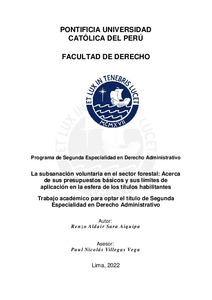La subsanación voluntaria en el sector forestal: Acerca de sus presupuestos básicos y sus límites de aplicación en la esfera de los títulos habilitantes
Abstract
El presente trabajo de investigación aborda cómo la subsanación voluntaria
regulada en el sector forestal presenta problemas respecto a sus presupuestos
básicos y sus límites de aplicación. En esa línea, es que se plantea como
objetivo determinar si efectivamente se presentan problemas en su aplicación.
Para tal efecto, es que se evalúa cómo la regulación de la subsanación
voluntaria en el sector forestal genera confusión respecto de los presupuestos
básicos para su configuración, y si es necesario establecer límites a la
subsanación voluntaria regulada en el sector forestal. Producto de lo analizado,
se llegó a la conclusión que la subsanación voluntaria en el sector forestal
presenta problemas respecto a sus presupuestos básicos y sus límites de
aplicación. En relación a sus presupuestos básicos, porque la subsanación
voluntaria solo se configuraría en el marco de un procedimiento administrativo
sancionador, y, asimismo, porque se considera a la tala no autorizada como
infracción subsanable, cuando ello supone un daño a los recursos forestales,
siendo ello incongruente con lo regulado en el reglamento anteriormente
aludido. Por otro lado, respecto a sus límites de aplicación, no basta con que la
subsanación voluntaria no sea aplicable a sujetos reincidentes, sino que
además se evalúe la introducción de algunos límites de su aplicación, como
que su aplicación sea por única vez, que se considere la gravedad del daño
generado y que la subsanación voluntaria tardía sea considerada como un
posible factor atenuante de multa. This research work addresses how the voluntary rectification regulated in the
forestry sector presents problems with respect to its basic assumptions and its
limits of application. In this line, the objective is to determine if there are indeed
problems in its application. For this purpose, it is evaluated how the regulation
of voluntary correction in the forestry sector generates confusion regarding the
basic assumptions for its configuration, and if it is necessary to establish limits
to regulated voluntary correction in the forestry sector. As a result of the
analysis, it was concluded that voluntary rectification in the forestry sector
presents problems with respect to its basic budgets and its application limits. In
relation to its basic assumptions, because voluntary rectification would only be
configured within the framework of a sanctioning administrative procedure, and,
likewise, because unauthorized logging is considered a rectifiable infraction,
when it supposes damage to forest resources, being This is inconsistent with
what is regulated in the aforementioned regulation. On the other hand,
regarding its limits of application, it is not enough that the voluntary correction is
not applicable to repeat offenders, but also that the introduction of some limits
of its application be evaluated, such as that its application be only once, that it
be consider the seriousness of the damage generated and that late voluntary
rectification is considered as a possible mitigating factor for a fine.
Temas
Procedimiento administrativo--Perú
Sanciones administrativas
Recursos forestales--Perú
Responsabilidad legal
Sanciones administrativas
Recursos forestales--Perú
Responsabilidad legal
Para optar el título de
Segunda Especialidad en Derecho Administrativo
Collections
The following license files are associated with this item:






